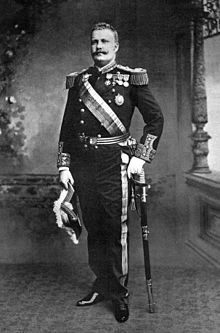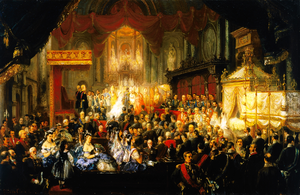| Revision as of 01:50, 24 May 2014 editDaniel*D (talk | contribs)141 edits Undid revision 609880197 by 186.31.20.28 (talk)← Previous edit | Revision as of 06:17, 24 May 2014 edit undo186.31.20.28 (talk) Undid revision 609889136 by Daniel*D (talk)Next edit → | ||
| Line 66: | Line 66: | ||
| # Infanta Maria Ana of Portugal (1888) | # Infanta Maria Ana of Portugal (1888) | ||
| # ] between 1908 and 1910 (1889–1932) | # ] between 1908 and 1910 (1889–1932) | ||
| # Infanta Maria of Portugal (1904-1998) | |||
| ] (1907–1995) had claimed (many years after his death) that she was the bastard daughter of King Carlos I by Maria Amélia Laredó e Murça. | ] (1907–1995) had claimed (many years after his death) that she was the bastard daughter of King Carlos I by Maria Amélia Laredó e Murça. | ||
Revision as of 06:17, 24 May 2014
You can help expand this article with text translated from the corresponding article in Portuguese. (January 2012) Click for important translation instructions.
|
| This article includes a list of references, related reading, or external links, but its sources remain unclear because it lacks inline citations. Please help improve this article by introducing more precise citations. (January 2010) (Learn how and when to remove this message) |
| Carlos I Charles I | |||||
|---|---|---|---|---|---|
 | |||||
| King of Portugal and the Algarves | |||||
| Reign | 19 October 1889 – 1 February 1908 | ||||
| Predecessor | Luís I | ||||
| Successor | Manuel II | ||||
| Born | 28 September 1863 Lisbon, Portugal | ||||
| Died | 1 February 1908 (aged 44) Terreiro do Paço, Lisbon, Portugal | ||||
| Burial | Royal Pantheon of the House of Braganza | ||||
| Spouse | Amélie of Orléans | ||||
| Issue | Luís Filipe, Prince Royal of Portugal Manuel II | ||||
| |||||
| House | House of Braganza House of Braganza-Saxe-Coburg and Gotha(disputed) | ||||
| Father | Luís I | ||||
| Mother | Maria Pia of Savoy | ||||
| Religion | Roman Catholic | ||||
Carlos I (Portuguese pronunciation: [ˈkaɾɫuʃ]; English: Charles I) the Diplomat (also known as the Martyr; Template:Lang-pt; 28 September 1863 – 1 February 1908) was the King of Portugal and the Algarves. He was the first Portuguese king to die a violent death since Sebastian of Portugal (1578). This occurred in 1908, when D. Carlos was murdered in Lisbon as he travelled in an open carriage with the royal family.
Early life



Carlos was born in Lisbon, Portugal, the son of King Luís and Queen Maria Pia of Savoy, daughter of Victor Emmanuel II, King of Italy. He had a brother, Infante Afonso, Duke of Porto. He was baptised with the names Carlos Fernando Luís Maria Víctor Miguel Rafael Gabriel Gonzaga Xavier Francisco de Assis José Simão.
His paternal first cousins included Frederick Augustus III of Saxony, Princess Maria Josepha of Saxony, Prince Wilhelm of Hohenzollern-Sigmaringen and Ferdinand I of Romania.
His maternal first cousins included Napoléon Victor Bonaparte, Victor Emmanuel III of Italy, Emanuele Filiberto, 2nd Duke of Aosta, Vittorio Emanuele, Count of Turin, Luigi Amedeo, Duke of the Abruzzi, Umberto, Count of Salemi.
He had an intense education and was prepared to rule as a constitutional monarch. In 1883 he traveled to Italy, England, France and Germany where he increased his knowledge of the modern civilization of his time. In 1883, 1886 and 1888 he ruled as regent as his father was traveling in Europe, as it became tradition among the Portuguese constitutional kings. His father Luis I advised him to be modest and to study with focus.
His first bridal candidate was one of the daughters of Frederick III, German Emperor, but the issue of religion presented an insurmountable problem and the pressure of British diplomacy prevented the marriage. He then met and married Princess Amélie of Orléans, eldest daughter of Philippe, comte de Paris, pretender to the throne of France.
King of Portugal

Carlos became King on 19 October 1889. After the 1890 British Ultimatum, colonial treaties with the United Kingdom of Great Britain and Ireland (one signed in August 1890 that defined their African borders along the Zambezi and Congo rivers and another signed on 14 October 1899, that confirmed colonial treaties of the 17th century) stabilised the situation in Africa, ending Portuguese claims of sovereignty on the Pink Map. These agreements were however unpopular in Portugal where they were seen as being to the disadvantage of the country.
Domestically, Portugal was twice declared bankrupt – on 14 June 1892, and again on 10 May 1902 – causing industrial disturbances, socialist and republican antagonism and press criticism of the monarchy. Carlos responded by appointing João Franco as prime minister and subsequently accepting parliament's dissolution.
As a patron of science and the arts, King Carlos took an active part in the celebration of the 500th anniversary (in 1894) of the birth of Prince Henry the Navigator. The following year he decorated the Portuguese poet João de Deus in a ceremony in Lisbon. Carlos took a personal interest in deep-sea and maritime exploration, publishing an account of his own studies in this area.
| Royal styles of Carlos I of Portugal | |
|---|---|
 | |
| Reference style | His Most Faithful Majesty |
| Spoken style | Your Most Faithful Majesty |
| Alternative style | Sire |
Assassination
Main article: Lisbon RegicideOn 1 February 1908 the royal family returned from the palace of Vila Viçosa to Lisbon. They travelled by train to Barreiro and, from there, they took a steamer to cross the Tagus River and disembarked at Cais do Sodré in central Lisbon. On their way to the royal palace, the open carriage with Carlos I and his family passed through the Terreiro do Paço fronting on the river. While crossing the square, shots were fired from the crowd by two republican activists: Alfredo Costa and Manuel Buiça.
Buiça, a former army sergeant and sharpshooter, fired five shots from a rifle hidden under his long overcoat. The king died immediately, his heir, Luís Filipe, was mortally wounded, and Prince Manuel was hit in the arm. The Queen alone escaped injury. The two assassins were killed on the spot by police and bodyguards; an innocent bystander was also killed in the confusion. The royal carriage turned into the nearby Navy Arsenal, where, about twenty minutes later, the Prince Royal Luis Filipe died. Several days later, the younger son, Prince Manuel, was proclaimed King of Portugal; he was the last of the Braganza-Saxe-Coburg and Gotha dynasty and the last king as well.
Marriage and children
Carlos was married to Princess Amélie of Orléans in 1886. She was daughter of Prince Philippe, Count of Paris and Princess Marie Isabelle of Orléans. Their children were:
- Luis Filipe, Duke of Braganza (1887–1908)
- Infanta Maria Ana of Portugal (1888)
- Manuel II, King of Portugal between 1908 and 1910 (1889–1932)
- Infanta Maria of Portugal (1904-1998)
Maria Pia de Saxe-Coburgo e Bragança (1907–1995) had claimed (many years after his death) that she was the bastard daughter of King Carlos I by Maria Amélia Laredó e Murça.
Ancestry
References
- Jean Pailler: D. Carlos I – Rei de Portugal: Destino Maldito de um Rei Sacrificado. Bertrand, Lisbon, 2001, ISBN 978-972-25-1231-2
- Jean Pailler: Maria Pia: A Mulher que Queria Ser Rainha de Portugal. Bertrand, Lisbon, 2006, ISBN 972-25-1467-9
- Manuel Amaral: Portugal – Dicionário Histórico, Corográfico, Heráldico, Biográfico, Bibliográfico, Numismático e Artístico, Volume II, 1904–1915, págs. 759
- Rui Ramos: D. Carlos, Temas e Debates, Lisbon, 2007.
| Carlos I of Portugal House of Braganza-Saxe-Coburg and GothaCadet branch of the House of Saxe-Coburg and GothaBorn: 28 September 1863 Died: 1 February 1908 | ||
| Regnal titles | ||
|---|---|---|
| Preceded byLuís I | King of Portugal and the Algarves 19 October 1889 – 1 February 1908 |
Succeeded byManuel II |
| Portuguese royalty | ||
| Preceded byPedro V | Prince Royal of Portugal 28 September 1863 – 19 October 1889 |
Succeeded byLuís Filipe |
| Duke of Braganza 28 September 1863 – 19 October 1889 | ||
| Monarchs of Portugal | ||
|---|---|---|
| House of Burgundy (1139–1383) |  | |
| House of Aviz (1385–1580) | ||
| House of Habsburg (1581–1640) | ||
| House of Braganza (1640–1910) | ||
| Debatable or disputed rulers are in italics. | ||
| Dukes of Braganza | ||
|---|---|---|
| Feudal Dukes |  | |
| Heir to the Throne | ||
| Claimant to the Throne | ||
| Infantes of Portugal | |
|---|---|
| The generations indicate descent from Afonso I, and continues through the House of Aviz, the House of Habsburg through Infanta Isabel, Holy Roman Empress and Queen of Spain, and the House of Braganza through Infanta Catarina, Duchess of Braganza. | |
| 1st generation | |
| 2nd generation | |
| 3rd generation | |
| 4th generation | |
| 5th generation | |
| 6th generation | |
| 7th generation | |
| 8th generation | |
| 9th generation | |
| 10th generation | |
| 11th generation | |
| 12th generation | |
| 13th generation | |
| 14th generation | |
| 15th generation | |
| 16th generation | |
| 17th generation | |
| 18th generation |
|
| 19th generation | |
| 20th generation | |
| 21st generation | |
| 22nd generation | |
| 23rd generation | |
| 24th generation | |
| * also an infante of Castile and León, Aragon, Sicily and Naples, § also an infante of Spain and an archduke of Austria, # also an infante of Spain, ‡ also an imperial prince of Brazil, ¶ also a prince of Saxe-Coburg and Gotha, Duke in Saxony, ◙ also a prince of Braganza, ¤ title removed in 1920 as their parents' marriage was deemed undynastic, ƒ claimant infante | |
| House of Braganza-Saxe-Coburg and Gotha | ||
|---|---|---|
| 1st generation |
|  |
| 2nd generation | ||
| 3rd generation |
| |
| The House of Saxe-Coburg and Braganza was not a recognized house in the former Kingdom of Portugal and monarchs following Maria II and Ferdinand II officially continued to be members of the House of Braganza | ||
| Princes of Saxe-Coburg and Gotha | |||||||||||||
|---|---|---|---|---|---|---|---|---|---|---|---|---|---|
| Forefather | Duke Francis I* | ||||||||||||
| 1st generation | |||||||||||||
| 2nd generation |
| ||||||||||||
| 3rd generation |
| ||||||||||||
| 4th generation |
| ||||||||||||
| 5th generation |
| ||||||||||||
| 6th generation |
| ||||||||||||
| 7th generation |
| ||||||||||||
| *Titled as Princes of Saxe-Coburg-Saalfeld before 11 February 1826 | |||||||||||||
Categories:
- Use dmy dates from May 2011
- 1863 births
- 1908 deaths
- 1908 crimes
- Assassinated Portuguese people
- Assassinated royalty
- Burials at the Monastery of São Vicente de Fora
- Deaths by firearm in Portugal
- Dukes of Braganza
- Grand Masters of the Order of the Immaculate Conception of Vila Viçosa
- House of Braganza-Saxe-Coburg and Gotha
- Knights of the Garter
- Murdered monarchs
- Portuguese monarchs
- Princes Royal of Portugal
- Portuguese royalty
- Recipients of the Royal Victorian Chain
- Roman Catholic monarchs
- Knights of the Order of the Most Holy Annunciation
- People from Lisbon